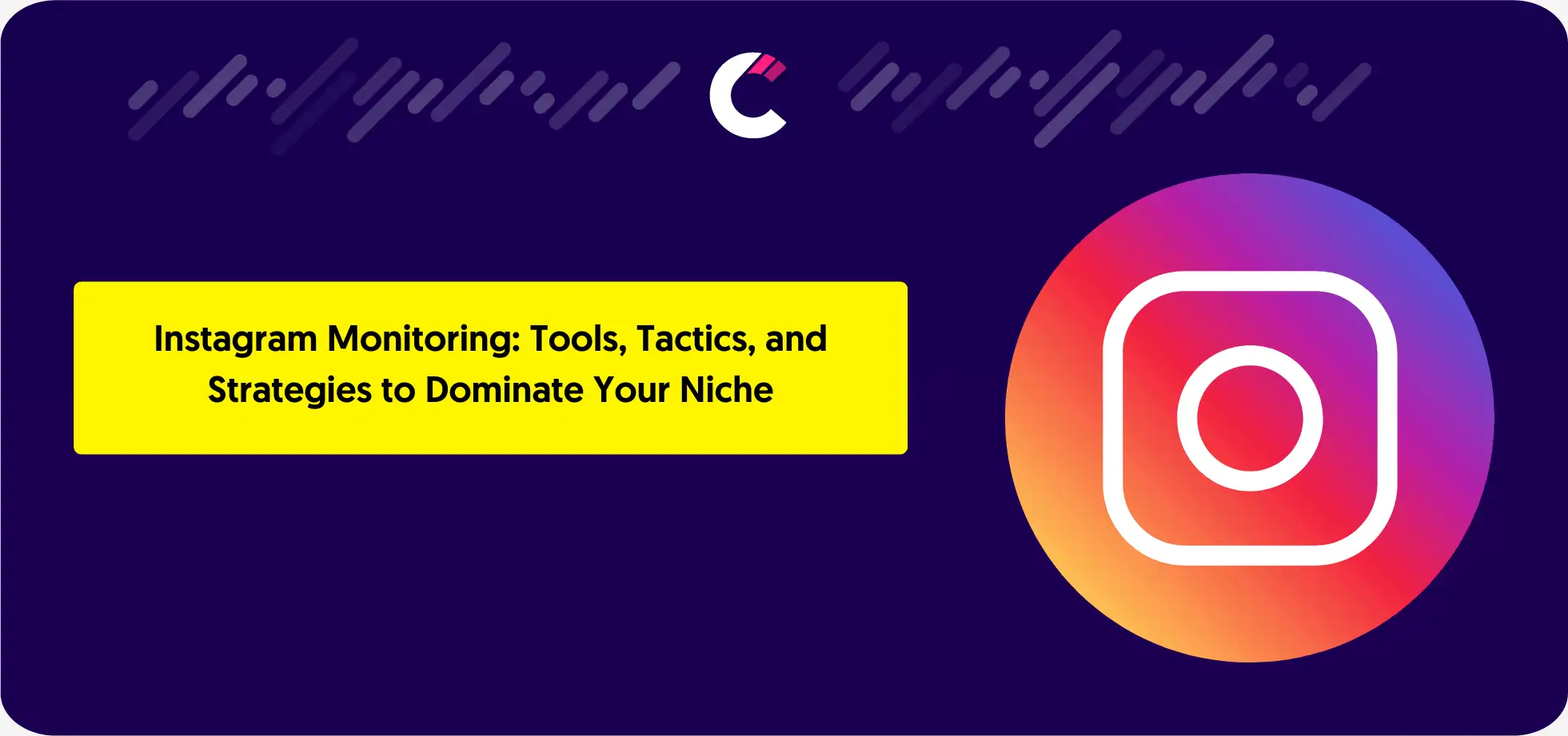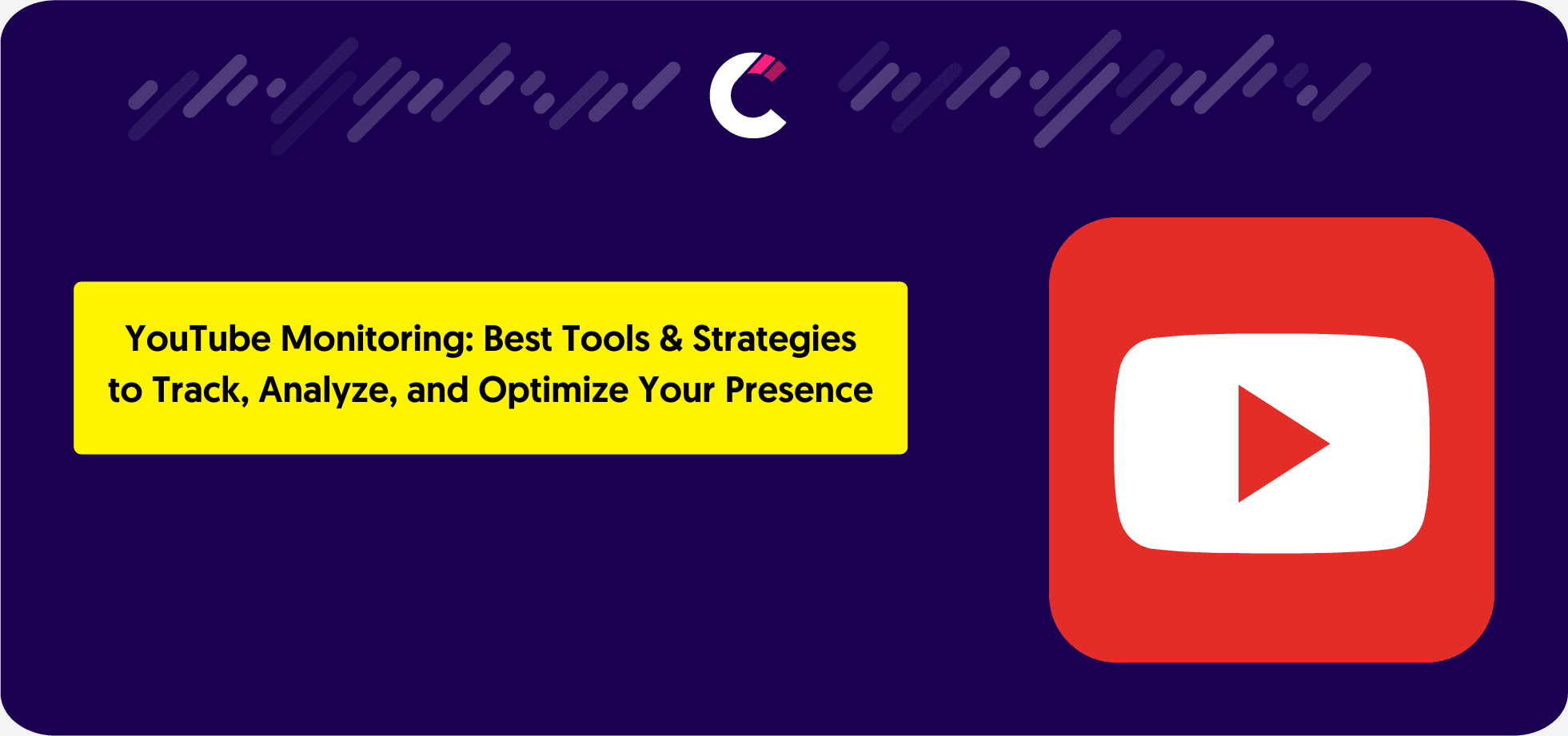When building and launching successful products, two roles often work behind the scenes to make it happen: product marketing and product management. At first glance, the two might seem similar, but their contributions are distinct and essential.
Product marketing ensures that the right audience connects with the product by crafting compelling messaging, positioning, and go-to-market strategies.
On the other hand, product management focuses on designing and building products that meet customer needs while aligning with business objectives.
Understanding the differences between product marketing and product management isn’t just helpful for businesses—it’s critical for professionals exploring these roles.
This post breaks down what each role entails, their responsibilities, and how they complement each other to drive growth.
By the end, you’ll have a clear picture of where these roles overlap, how they differ, and which one might be the right fit for your strengths and career goals.
What is Product Marketing?
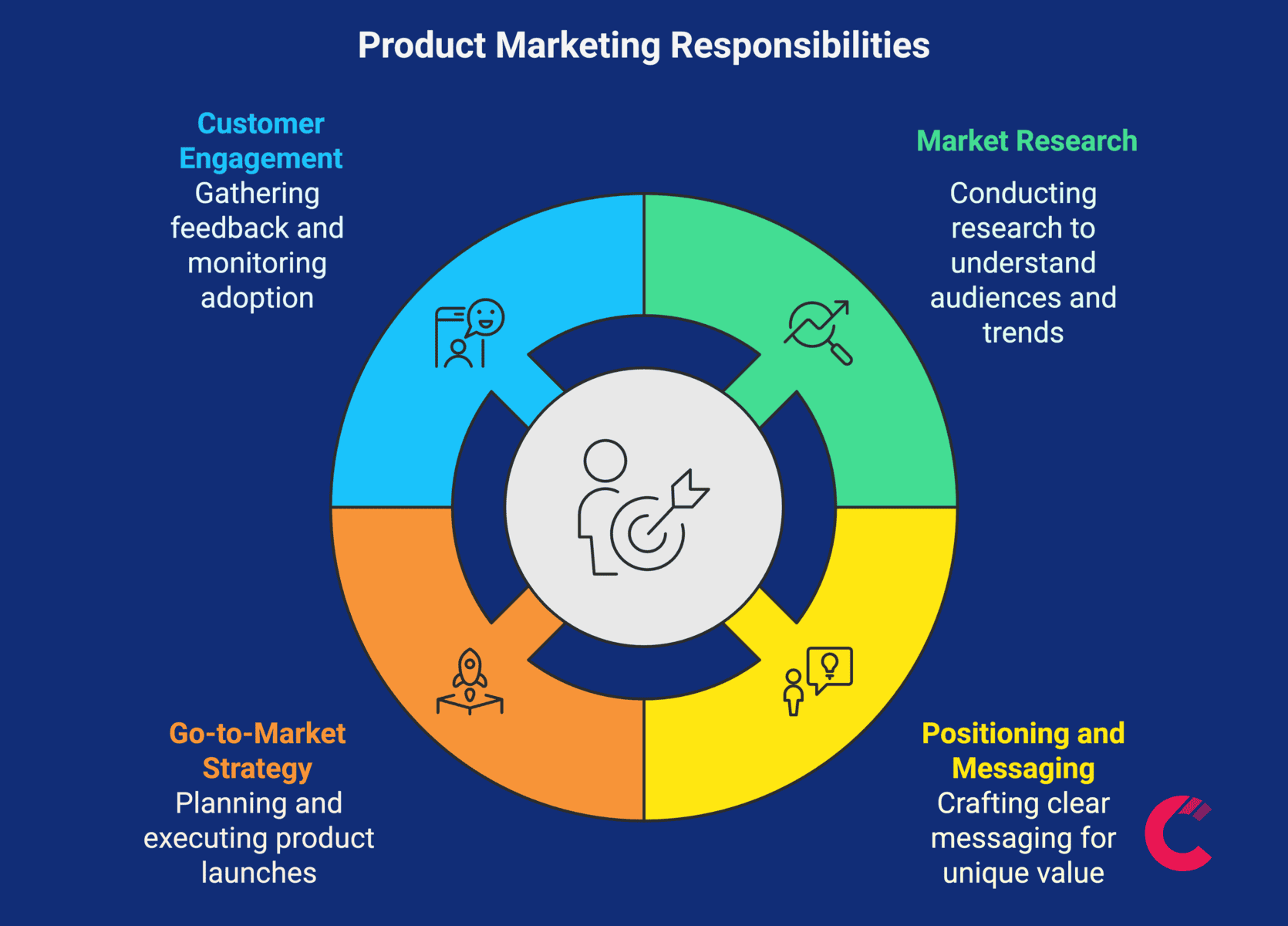
Product marketing is the bridge between a product and its audience. It involves crafting strategies to ensure that a product resonates with the right people at the right time. This role is all about understanding the target audience, positioning the product effectively in the market, and creating compelling messaging that highlights its value.
At its core, product marketing focuses on answering key questions: Who is the product for? What problems does it solve? Why should customers care? A product marketing manager often collaborates with sales, product teams, and marketing departments to create go-to-market strategies, drive product adoption, and ensure long-term customer satisfaction.
The success of product marketing lies in its ability to align customer needs with the product’s benefits, ensuring that the product not only stands out but also delivers measurable business results.
The Core Responsibilities of Product Marketing
Product marketing revolves around a specific set of responsibilities that ensure a product’s success in the market. These responsibilities focus on connecting the product to its audience and driving engagement, adoption, and revenue. Below are the core areas where product marketing managers contribute significantly:
- Market Research and Customer Insights
- Conducting in-depth research to understand target audiences, market trends, and customer pain points.
- Analyzing competitors to identify positioning opportunities.
- Positioning and Messaging
- Crafting clear and compelling messaging that highlights the product’s unique value proposition.
- Ensuring consistent communication across all channels to align with customer expectations.
- Go-to-Market Strategy
- Planning and executing product launches, from creating promotional materials to collaborating with cross-functional teams.
- Aligning marketing efforts with sales goals to drive revenue.
- Customer Engagement and Feedback
- Partnering with customer success teams to gather feedback and improve messaging.
- Monitoring product adoption metrics and adjusting strategies accordingly.
By handling these responsibilities, product marketers play a pivotal role in making sure the right audience discovers, understands, and values the product.
How Product Marketing Supports Business Goals
The role of product marketing goes beyond just promoting a product; it directly contributes to achieving key business objectives. By aligning customer needs with strategic initiatives, product marketing ensures that a product’s value resonates with its target audience, ultimately driving growth and profitability.
- Increasing Revenue Through Market Alignment
Product marketers identify the right audience segments and craft messaging that highlights a product’s relevance. This targeted approach boosts customer acquisition and retention, directly impacting revenue growth. - Driving Product Adoption
Effective go-to-market strategies ensure that the product gains traction in competitive markets. Product marketing managers work to increase awareness and adoption through campaigns, product launches, and ongoing engagement. - Enhancing Brand Positioning
A strong positioning strategy not only benefits the product but also elevates the company’s brand. By ensuring the product is viewed as a solution to real customer problems, product marketing strengthens the company’s reputation in the industry. - Supporting Sales Teams
Product marketing bridges the gap between product development and sales by creating sales enablement materials like pitch decks, case studies, and FAQs. This equips sales teams with the tools they need to close deals efficiently.
In short, product marketing aligns product success with broader business goals, making it an essential driver for sustainable growth.
What is Product Management?
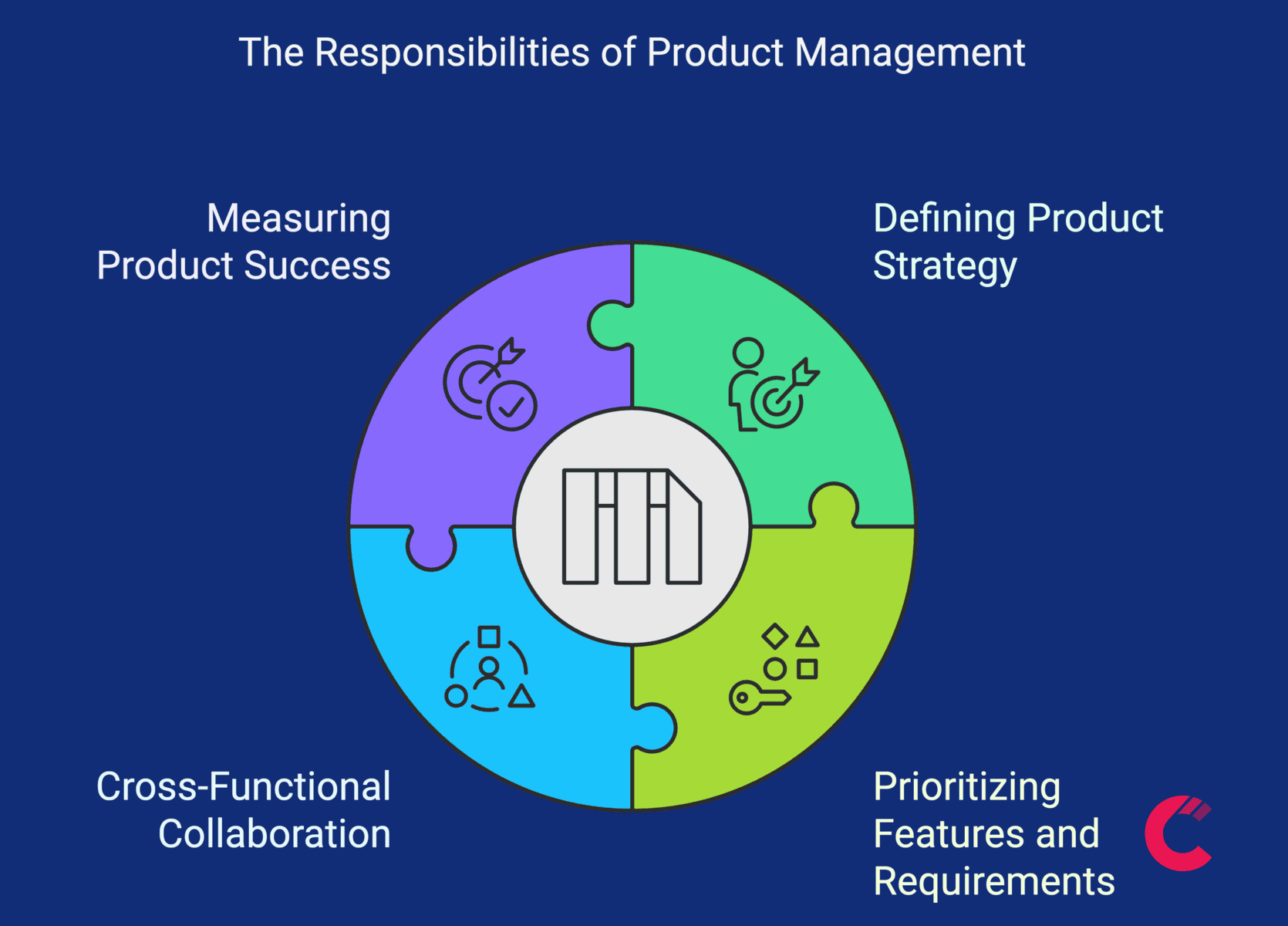
Product management is the process of guiding a product from its initial concept to its delivery and beyond. It involves managing the product lifecycle by understanding customer needs, defining the product vision, and working closely with cross-functional teams to bring that vision to life. Product management ensures that the product solves real problems while meeting business goals and market demands.
A product manager acts as the owner of the product, balancing technical, customer, and business perspectives. This role often requires close collaboration with engineering, design, marketing, and sales teams to ensure the product’s success. Product managers focus on answering questions such as: What should we build? Why should we build it? How will we measure its success?
Below, we’ll dive deeper into the responsibilities and role of product management across the product lifecycle.
The Core Responsibilities of Product Management
The responsibilities of product management revolve around strategy, execution, and collaboration. Here are the key areas where product managers drive impact:
- Defining Product Strategy
- Establishing a clear vision and roadmap for the product, ensuring it aligns with customer needs and business goals.
- Prioritizing Features and Requirements
- Working with stakeholders to identify and prioritize features that deliver the highest value.
- Cross-Functional Collaboration
- Acting as the central point of communication between design, engineering, and business teams to ensure alignment during product development.
- Measuring Product Success
- Defining key performance indicators (KPIs) to track product performance and iterating based on data-driven insights.
Product Management Across the Product Lifecycle
Product management responsibilities evolve depending on the stage of the product lifecycle:
- Ideation and Conceptualization
- Conducting market research to identify gaps and opportunities.
- Developing product concepts and defining value propositions.
- Development and Execution
- Collaborating with engineering and design teams to translate ideas into functional products.
- Ensuring timely delivery by managing timelines and resolving roadblocks.
- Launch and Market Entry
- Partnering with product marketing to support go-to-market strategies.
- Ensuring the product is positioned effectively for its target audience.
- Post-Launch Optimization
- Monitoring feedback and usage data to identify improvement opportunities.
- Collaborating on updates and feature enhancements to keep the product competitive.
Product management is a dynamic role that adapts to the changing needs of the product and its market, ensuring continuous value delivery.
Product Marketing vs Product Management: Key Differences
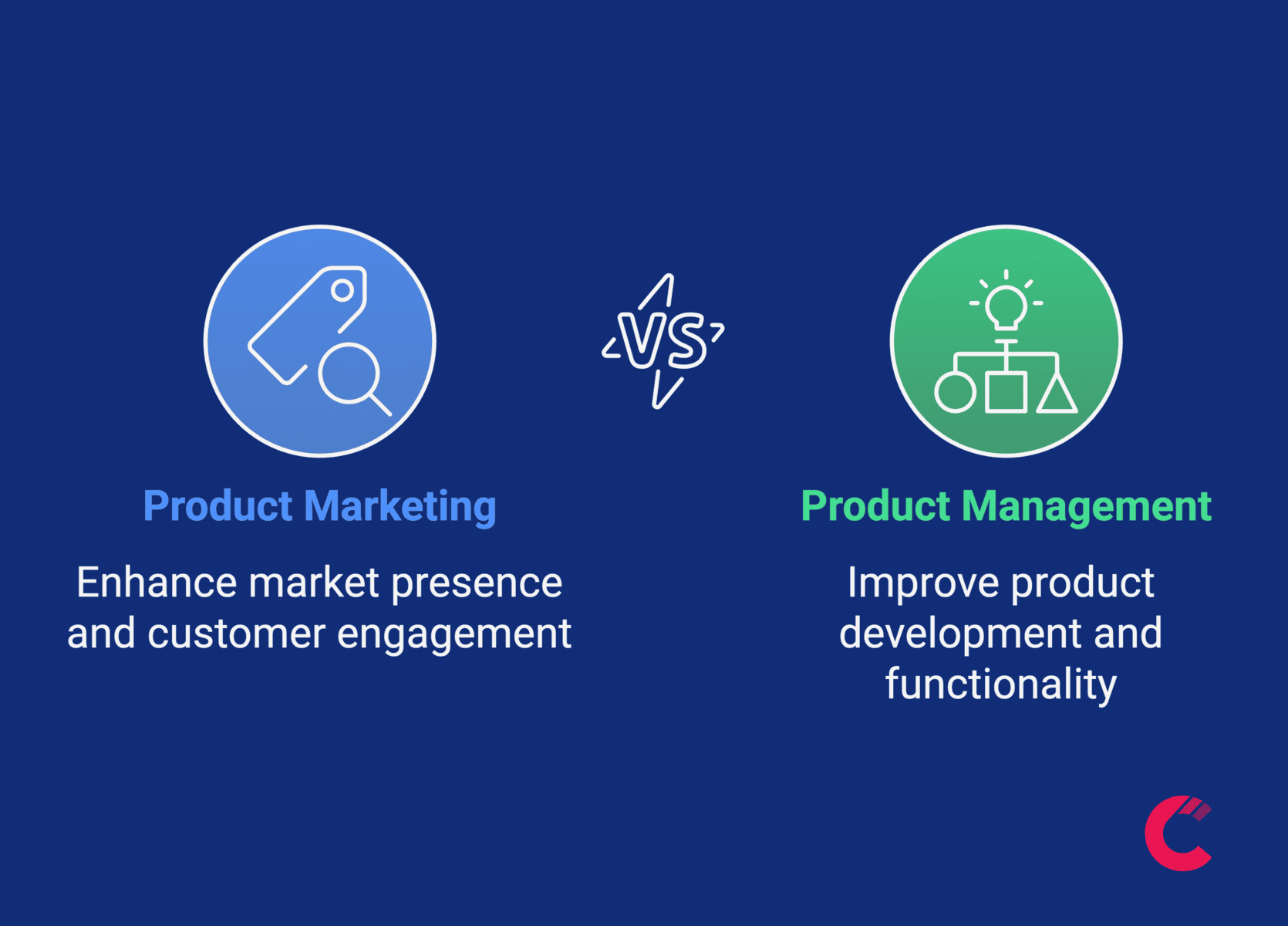
While product marketing and product management work towards the shared goal of ensuring a product’s success, their roles, responsibilities, and focus areas are distinct. This section outlines their differences, highlights overlapping areas, and explores opportunities for collaboration.
Distinct Roles and Responsibilities
Product Marketing
- Focuses on understanding the market and target audience to craft effective positioning and messaging.
- Manages go-to-market strategies, product launches, and campaigns to drive awareness and adoption.
- Works closely with sales teams to develop enablement materials and refine customer communication.
Product Management
- Concentrates on the product itself—defining its vision, roadmap, and features.
- Collaborates with engineering and design teams to develop and deliver the product.
- Focuses on product optimization through data analysis and feedback to improve functionality and user experience.
The fundamental distinction lies in their scope: product marketing looks outward at the market and audience, while product management focuses inward on the product’s creation and improvement.
Overlapping Areas and Collaboration Opportunities
Despite their distinct roles, product marketing and product management share overlapping responsibilities:
- Customer Insights: Both rely on understanding customer needs, though product marketing uses this to shape messaging, while product management uses it to define features.
- Go-to-Market Strategy: Product managers and marketers often collaborate on launch plans to ensure alignment between product features and audience expectations.
- Feedback Loops: Marketers gather feedback from campaigns, while product managers use it to inform updates or future developments.
Opportunities for Collaboration
- Messaging and Positioning: Product managers provide input on the product’s core value, while marketers craft messages that resonate with the audience.
- Roadmap Alignment: Both roles must sync on timelines for feature releases and marketing campaigns to maximize impact.
- Customer Success: Collaborative efforts to improve the user journey ensure a seamless experience from adoption to retention.
Understanding these distinctions and overlaps is essential for businesses to leverage the strengths of both roles effectively, ensuring better product outcomes and stronger market presence.
Skills Comparison: Product Marketing vs Product Management
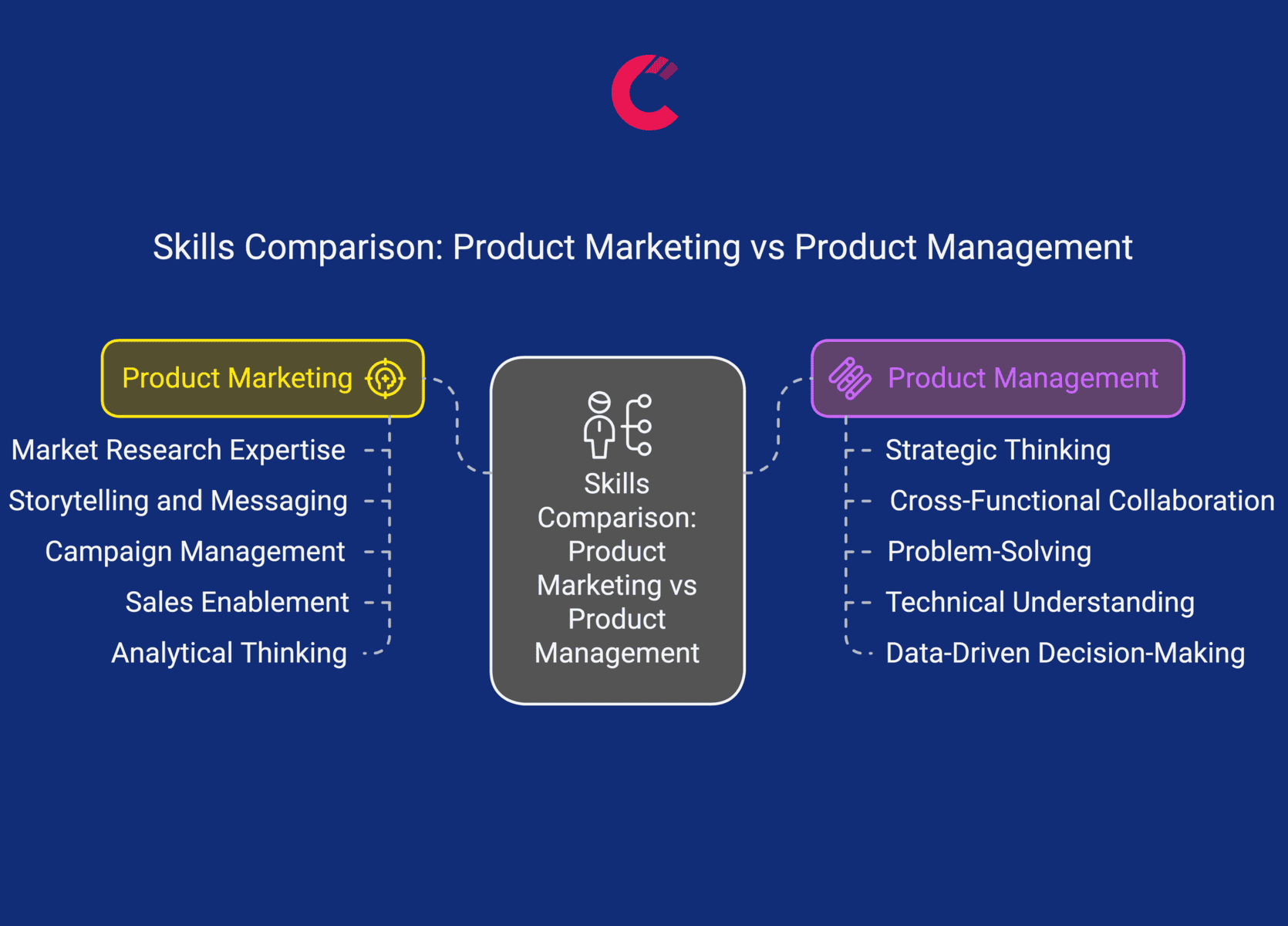
While product marketing and product management require different skill sets, both roles share competencies that ensure product success. Understanding the required skills for each role can help professionals identify where their strengths align and where to focus their growth efforts. Let’s dive into the unique and shared skills of product marketers and product managers, and how these skills contribute to their roles.
Essential Skills for Product Marketers
- Market Research Expertise
- Product marketers need a deep understanding of their target audience, industry trends, and competitors.
- This involves gathering insights to craft messaging that resonates with potential customers.
- Storytelling and Messaging
- Crafting compelling narratives that highlight a product’s value proposition is a key skill.
- Product marketers must create messaging that connects emotionally and logically with the audience.
- Campaign Management
- Strong project management skills are necessary to run effective product launches and promotional campaigns.
- Coordinating with teams to ensure consistency across all channels is also crucial.
- Sales Enablement
- Product marketers work closely with sales teams to provide materials, training, and strategies that support conversions.
- Developing assets like case studies, presentations, and FAQs is a core responsibility.
- Analytical Thinking
- Metrics such as campaign ROI, adoption rates, and customer feedback are critical for evaluating success and optimizing strategies.
Essential Skills for Product Managers
- Strategic Thinking
- Product managers must align the product roadmap with business goals and customer needs.
- This requires prioritizing features and defining long-term product vision.
- Cross-Functional Collaboration
- Working effectively with engineering, design, marketing, and sales teams is essential to bring a product to life.
- Problem-Solving
- Product managers analyze customer pain points and find innovative solutions to address them.
- Technical Understanding
- While not always developers, product managers need a working knowledge of technical concepts to communicate effectively with engineering teams.
- Data-Driven Decision-Making
- Using metrics like user engagement, feature usage, and churn rates to refine the product is vital.
Shared Competencies and How They Differ
While both roles overlap in some areas, the way these competencies are applied varies:
- Customer Empathy
- Product marketers focus on understanding customer emotions and crafting messages that resonate.
- Product managers use empathy to design features that solve real problems.
- Communication
- Marketers are skilled at outward communication, such as creating campaigns and public-facing content.
- Managers excel at internal communication, ensuring alignment across teams.
- Analytical Thinking
- Both roles rely on data, but marketers focus on campaign metrics, while managers track product performance and user behavior.
- Adaptability
- Product marketers pivot strategies based on market feedback.
- Product managers adjust product priorities based on development challenges or changing customer needs.
Collaboration Between Product Marketers and Product Managers
For any product to succeed, product marketers and product managers must work together seamlessly. While their responsibilities differ, their collaboration ensures that a product is not only well-built but also well-positioned and effectively promoted. This synergy is critical for delivering a cohesive customer experience and meeting business goals.
Examples of Effective Teamwork
- Product Launches
- During a product launch, product marketers handle go-to-market strategies, messaging, and audience outreach. Meanwhile, product managers ensure the product is ready for release, aligning features with customer needs and addressing potential technical issues.
- For example, a product manager might highlight a feature’s technical advantage, while a marketer translates that advantage into customer-focused benefits through campaigns.
- Customer Feedback Loops
- Marketers collect feedback from campaigns, surveys, and sales teams to understand customer perceptions. This feedback is shared with product managers, who analyze it to refine the product or prioritize future updates.
- Collaboration ensures that improvements align with both market demand and technical feasibility.
- Positioning and Messaging
- Product managers provide insights into what makes the product unique and its technical strengths. Product marketers take these inputs to create compelling positioning and messaging that resonates with the target audience.
- For instance, if a product manager highlights a feature like “AI-powered analytics,” marketers can position it as “saving hours of manual work with actionable insights.”
Key Challenges and How to Overcome Them
- Misaligned Priorities
- Product marketers often focus on short-term goals like campaigns and adoption, while product managers prioritize long-term development and feature delivery.
- Solution: Regularly scheduled meetings to align priorities, ensuring both teams understand each other’s timelines and constraints.
- Communication Barriers
- Technical jargon from product managers can sometimes disconnect from the customer-focused language marketers need, leading to miscommunication.
- Solution: Use shared documentation, such as a product brief, that bridges technical details with customer benefits.
- Conflicting Feedback Sources
- Marketers rely on external customer feedback, while product managers consider internal technical constraints. This can lead to disagreements on priorities.
- Solution: Collaborate on a unified feedback framework that incorporates input from both external (customers) and internal (development teams) sources.
- Ownership Disputes
- Questions about who “owns” certain aspects, such as customer insights or feature prioritization, can create friction.
- Solution: Clearly define roles and responsibilities at the start of every project to avoid overlapping efforts.
Transitioning Into Product Marketing or Product Management
Transitioning into product marketing or product management can be a highly rewarding career move, offering opportunities to influence how products are built, marketed, and delivered to customers. However, each role has unique pathways, skill requirements, and challenges that professionals should understand to ensure a smooth and successful transition.
Career Pathways for Product Marketers
- Starting Points
- Many product marketers begin in traditional marketing roles, such as content marketing, digital advertising, or social media management. These roles provide foundational skills like audience analysis, campaign planning, and messaging development.
- Alternatively, professionals from sales or customer success may transition into product marketing, leveraging their firsthand customer insights.
- Key Steps to Transition
- Develop Market Research Skills: Understand market dynamics, customer personas, and competitive positioning to create compelling strategies.
- Build Cross-Functional Experience: Collaborate with sales, product, and marketing teams to demonstrate your ability to bridge gaps.
- Showcase Campaign Success: Create a portfolio that highlights successful product launches or promotional campaigns.
- Industry-Specific Opportunities
- Product marketing is particularly prominent in tech and SaaS industries, where products require detailed positioning and go-to-market strategies.
- Consumer goods and healthcare sectors also provide opportunities for product marketers to communicate value propositions effectively.
- Advancing in the Field
- Entry-level roles such as product marketing associate or junior product marketer often lead to positions like product marketing manager or head of product marketing.
- Senior roles typically involve overseeing entire product portfolios or managing global campaigns.
Career Pathways for Product Managers
- Starting Points
- Technical Backgrounds: Many product managers start in engineering, software development, or quality assurance roles, gaining insight into the technical aspects of product development.
- Business or Operations Roles: Professionals in business analysis, project management, or operations often transition into product management by showcasing their strategic thinking and leadership skills.
- Key Steps to Transition
- Learn Product Lifecycle Management: Familiarize yourself with ideation, development, launch, and iteration phases.
- Develop Prioritization Skills: Show your ability to balance customer needs with business objectives and technical feasibility.
- Get Hands-On with Tools: Master commonly used tools like JIRA, Trello, or Asana to manage roadmaps and workflows.
- Industry-Specific Opportunities
- Product management is critical in industries such as technology, finance, e-commerce, and healthcare, where innovation and feature prioritization drive success.
- Startups offer a dynamic environment for aspiring product managers to take on diverse responsibilities early in their careers.
- Advancing in the Field
- Roles often start at associate product manager or junior product manager levels and can progress to senior titles such as director of product or chief product officer (CPO).
- Leadership positions may involve overseeing multiple product lines and driving long-term strategic goals.
Skills to Develop for a Successful Transition
Regardless of whether you aim to become a product marketer or product manager, certain skills are universally valuable and will enhance your chances of success:
- Customer-Centric Thinking
- Product Marketers: Focus on understanding customer motivations and crafting narratives that resonate.
- Product Managers: Dive deep into customer pain points to design solutions that address their needs effectively.
- Strategic Vision
- Marketers must align go-to-market strategies with overall business goals, while managers must map product roadmaps to customer and organizational priorities.
- Communication Skills
- Clear communication is critical for working with cross-functional teams, whether it’s conveying technical details or presenting campaign strategies.
- Analytical Abilities
- Product marketers should be adept at campaign analytics and customer insights, while product managers need to analyze feature performance and user behavior.
- Adaptability
- Both roles require flexibility to pivot based on feedback, changing priorities, or unexpected challenges.
- Collaboration
- Success in both roles hinges on the ability to work effectively with stakeholders, including engineering, sales, marketing, and design teams.
Additional Tips for Transitioning
- Gain Certifications: For product marketing, consider certifications like Pragmatic Institute’s Product Marketing Certification. For product management, courses like General Assembly’s Product Management Bootcamp or certifications from AIPMM can be beneficial.
- Leverage Networking: Join communities such as Product Marketing Alliance or Product School to connect with professionals in these roles.
- Start Small: If transitioning within your organization, take on side projects or assist existing product teams to demonstrate your capabilities.
Seek Mentorship: Learning from experienced product marketers or managers can provide invaluable insights into navigating challenges and excelling in your new role.
Product Marketing vs Product Management: Pros and Cons
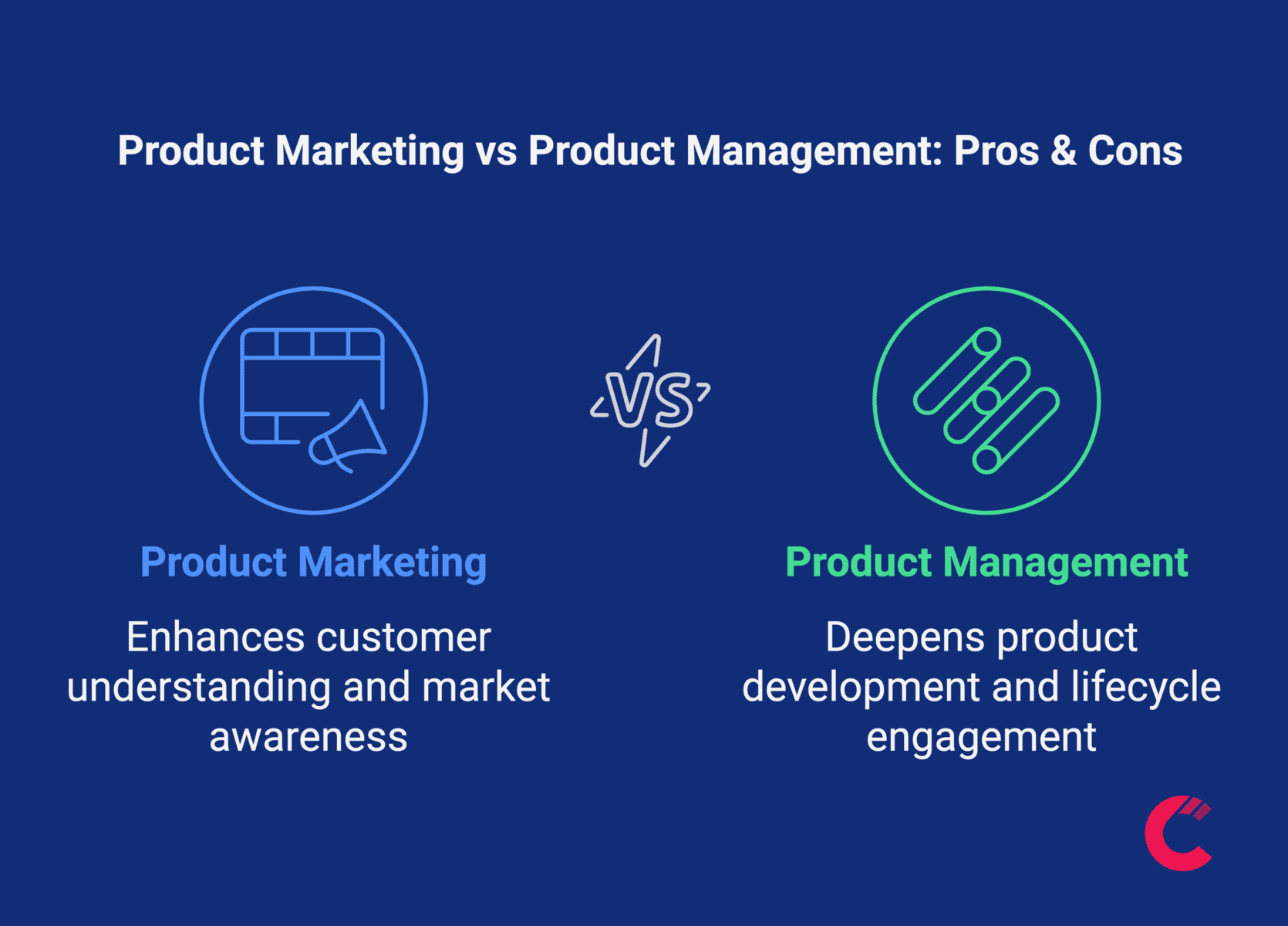
Choosing between a career in product marketing or product management depends on your skills, interests, and long-term goals. Both roles offer unique opportunities and challenges, making it crucial to evaluate their pros and cons before deciding on the right path for you.
Choosing the Right Career Path for Your Strengths
Product Marketing Pros:
- Customer Connection: You get to craft compelling messaging that directly resonates with customers.
- Creative Freedom: There’s room for creativity in developing campaigns, positioning strategies, and content.
- Market Insights: You gain a deep understanding of customer behavior and industry trends.
- Cross-Functional Collaboration: You work closely with sales, marketing, and product teams, which broadens your professional network.
Product Marketing Cons:
- Pressure to Deliver Results: Metrics like adoption rates, campaign ROI, and sales enablement success often define your performance.
- Dependent on Product Teams: Success in product marketing relies on timely input from product managers and developers.
- Less Influence on Product Design: Marketers often have minimal input into the product itself, focusing instead on how to position it in the market.
Product Management Pros:
- Ownership of the Product: You have a direct impact on shaping the product and its features.
- Strategic Influence: Product managers are often involved in high-level decisions that drive business objectives.
- Problem-Solving Opportunities: You get to address real customer pain points through innovative solutions.
- Diverse Skill Development: The role requires technical, analytical, and leadership skills, making it highly versatile.
Product Management Cons:
- Heavy Responsibility: Managing the entire product lifecycle can be overwhelming.
- Frequent Trade-Offs: Balancing stakeholder expectations, technical constraints, and customer needs is challenging.
Long Development Cycles: Unlike marketing, results from product decisions can take time to materialize.
Common Misconceptions About Each Role
Product Marketing Misconceptions:
- “It’s just about advertising.”
- Reality: Product marketing is about much more than promotions; it includes strategic positioning, market research, and aligning messaging with customer needs.
- “Marketers don’t need to know the product in depth.”
- Reality: A successful product marketer must have a thorough understanding of the product to communicate its value effectively.
Product Management Misconceptions:
- “Product managers are just project managers.”
- Reality: While there’s overlap, product managers focus on defining the product vision and ensuring it aligns with customer and business goals.
- “You need to be highly technical to succeed.”
- Reality: While technical knowledge helps, the role is more about problem-solving, communication, and strategy than coding or engineering.
Product Marketing and Product Management in Practice
To better understand how product marketing and product management contribute to a product’s success, let’s explore real-world examples where these roles played pivotal parts in achieving business objectives.
Case Study: How HubSpot’s Product Marketing Drove a Successful Product Launch
The Challenge:
HubSpot, a leader in inbound marketing software, launched its Operations Hub in 2021 to help businesses streamline operations by centralizing data and automating workflows. Competing against established tools like Zapier and Asana, HubSpot needed a strategy to differentiate its product and drive adoption. (Source)
The Role of Product Marketing:
- Market Research and Positioning
- HubSpot’s team conducted competitive analysis and customer surveys to identify pain points around disconnected tools and inefficient processes.
- They positioned Operations Hub as an all-in-one solution that eliminated silos by integrating seamlessly with existing tools.
- Messaging and Campaign Development
- Messaging focused on benefits like “no-code automation” and “real-time data sync.”
- A multi-channel marketing campaign included blog posts, webinars, and email campaigns targeting HubSpot’s existing customer base.
- Sales Enablement
- Product marketing created training resources, one-pagers, and demo videos to empower the sales team to pitch the product effectively.
Results:
- The launch of Operations Hub contributed significantly to HubSpot’s 41% year-over-year revenue growth in Q2 2021, making it a standout addition to its CRM platform.
Case Study: Tesla’s Product Management and Strategic Decision-Making
The Challenge:
Tesla’s ambition to lead the EV market required addressing range anxiety and high costs—key barriers to adoption. Tesla’s product management team needed to create a roadmap that balanced customer expectations with technical feasibility while scaling production efficiently. (Source)
The Role of Product Management:
- Customer Insights and Feature Prioritization
- The team prioritized long-range battery technology and affordability based on market data.
- Their efforts were focused on the Model 3, targeting mass-market adoption with an affordable EV offering.
- Cross-Functional Collaboration
- Product managers coordinated closely with engineering teams to optimize battery efficiency and collaborated with design teams to create a sleek, aerodynamic product.
- They worked with manufacturing teams to ensure scalable production using Tesla’s Gigafactory model.
- Launch and Continuous Improvement
- The Model 3 launched with a starting price of $35,000, a competitive price point designed to drive adoption.
- Tesla utilized over-the-air software updates to improve features like autopilot post-launch.
Results:
- By 2020, the Model 3 became the world’s best-selling EV, with over 500,000 units delivered that year. Tesla’s approach solidified its reputation as a leader in the EV market, contributing to the company’s $800 billion market valuation in 2021.
FAQs: Product Marketing vs Product Management
What Does a Product Marketing Manager Do?
A product marketing manager (PMM) is responsible for ensuring that a product resonates with its target audience. They focus on positioning, messaging, and go-to-market strategies while aligning marketing campaigns with sales objectives. Their tasks typically include:
- Conducting market research to understand customer needs and competitive landscapes.
- Crafting compelling product messaging that highlights unique value propositions.
- Coordinating with sales teams to provide enablement tools like case studies, pitch decks, and FAQs.
- Tracking adoption rates and campaign performance to adjust strategies as needed.
What Does a Product Manager Do?
A product manager (PM) oversees the development and lifecycle of a product. Their primary focus is on defining the product roadmap, managing cross-functional teams, and ensuring the product solves real customer problems. Key responsibilities include:
- Collecting and analyzing customer feedback to prioritize features and updates.
- Collaborating with engineering and design teams to bring ideas to life.
- Monitoring KPIs like feature adoption, retention, and user satisfaction.
- Aligning product decisions with broader business goals to deliver value for both customers and stakeholders.
Are There Similarities Between the Two Roles?
Yes, product marketing and product management share some commonalities, but they apply these skills differently:
- Customer Insights
- Both roles require a deep understanding of customer pain points and motivations.
- Marketers use this to craft messaging, while managers prioritize product features.
- Collaboration
- Both work closely with cross-functional teams, including engineering, design, and sales, to ensure product success.
- Data-Driven Decision-Making
- Marketers analyze campaign performance, while managers focus on product metrics like usage rates and retention.
How Do Product Marketing Managers and Product Managers Collaborate?
Collaboration between PMMs and PMs ensures a product’s success at every stage. Examples include:
- Product Launches: PMs ensure the product is ready, while PMMs develop and execute campaigns to promote it.
- Customer Feedback: PMMs collect feedback through campaigns, which PMs use to prioritize updates and improvements.
- Positioning: PMs provide technical insights, while PMMs translate those into customer-centric messaging.
Growth Product Manager vs Growth Marketing Manager: What’s the Difference?
While both roles aim to drive growth, their focus areas differ:
- Growth Product Manager:
- Focuses on improving product usage and retention by optimizing features and onboarding experiences.
- Works closely with engineering and design teams to implement solutions like personalized user flows or feature enhancements.
- Growth Marketing Manager:
- Focuses on acquiring new customers through campaigns, ads, and promotional strategies.
- Collaborates with sales and product teams to drive customer acquisition and engagement.
When Companies Need Both Roles:
Companies often hire both when they need specialized expertise to improve product performance (growth product manager) and expand the customer base (growth marketing manager).
What’s a Typical Day Like for These Roles?
A Day in the Life of a Product Manager:
- Start with reviewing feedback or usage data to identify areas for improvement.
- Meet with engineers to discuss development progress or resolve roadblocks.
- Collaborate with design teams to refine prototypes or mockups.
- Align with stakeholders on the product roadmap and key priorities.
A Day in the Life of a Product Marketing Manager:
- Begin by analyzing campaign metrics or adoption rates.
- Coordinate with sales teams to refine enablement materials or presentations.
- Plan upcoming marketing campaigns or webinars for a new product launch.
- Conduct customer interviews or competitive research to refine positioning.


